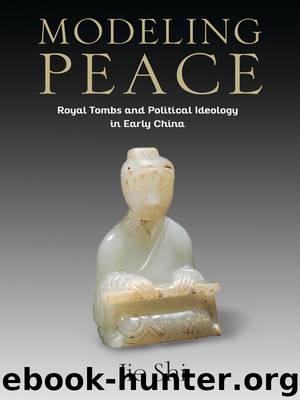Modeling Peace by Jie Shi

Author:Jie Shi
Language: eng
Format: epub
Tags: HIS002000, History/Ancient/General, HIS008000, History/Asia/China
Publisher: Columbia University Press
Published: 2020-03-24T00:00:00+00:00
EMBODYING POLITICAL IDEOLOGY AT MANCHENG
As the decision-maker and final authority on his mausoleum project, Liu Sheng possessed both the power and the motivation to implant his political ideology—a fusion of Huang-Lao thought and Confucianism—into the design of the tomb. Within the ideology of both Huang-Lao and Confucianism that Liu Sheng might have practiced, the fundamental task for the ruler was to imitate ancient sage kings in attaining personal well-being and extending it to the realization of the well-being of the world. However, no one believed this extension could be achieved in one quick step. Instead, it required a process, beginning with the cultivation of the self, passing through the harmony of the family and local communities, and eventually ending in the peace of the country (and further, “all under heaven”). Although it remains uncertain how definitively Liu Sheng, as the final authority on his burial project, requested the implementation of his personal political ideology, the multistepped process of pacification of the self, the family, and the state was certainly deeply embedded in the design of the Mancheng tombs.
At the Mancheng site, the union between the body and the soul was constructed through several nested coffins and caskets. The Mancheng designer furnished these zones as if a gradual natural transformation was occurring between a solid body in the center and an ethereal soul that surrounded the body. Across these layers, a multilayer “union” ensured the everlasting embrace of the body and the soul, which further ensured the longevity of the deceased subjects (see chapter 1).
Whereas the embracing principle linked up the body and the soul through a succession of transitional phases, the paralleling principle held the husband and the wife together by turning their tombs into each other’s mirror image, be it physically or symbolically. It appears as if the deceased couple were conceived as one unity, or as the Book of Etiquette and Ceremonial relates, “united in one body”85 (see chapter 2). The paralleling principle might have also encompassed the extended family as well, which consisted of other subordinate family members, as eighteen satellite burials with stone pyramids dot the lower mountain slopes at the site.86
The third principle, intermingling, encompassed the ethnic-Han and non-ethnic-Han elements in the tombs. A relatively small number of non-ethnic-Han elements, both symbolically and functionally, permeated the tomb space in all major aspects of living, including clothing, cooking, building, and transportation, and were mixed and integrated among the dominant ethnic-Han elements. More importantly, these non-ethnic-Han remains were not exotica that boasted of the owner’s social status, wealth, and distinction, but rather, they were associated specifically with the local Rong-Di cultural tradition in north Hebei (see chapter 3).
The three organizing principles in the tombs of the Mancheng site represent a special variation on the influential political discourse of a pacified ruler pacifying the world in second-century BCE China.87
In Huang-Lao teachings, personal longevity formed the foundation of good rulership. The opposite of longevity was death, which meant breaking the union of body and soul and resulting in the failure to cultivate the self.
Download
This site does not store any files on its server. We only index and link to content provided by other sites. Please contact the content providers to delete copyright contents if any and email us, we'll remove relevant links or contents immediately.
| Anthropology | Archaeology |
| Philosophy | Politics & Government |
| Social Sciences | Sociology |
| Women's Studies |
Mysteries by Colin Wilson(2896)
People of the Earth: An Introduction to World Prehistory by Dr. Brian Fagan & Nadia Durrani(2356)
Ancient Worlds by Michael Scott(2116)
Foreign Devils on the Silk Road: The Search for the Lost Treasures of Central Asia by Peter Hopkirk(2064)
The Memory Code by Lynne Kelly(1964)
Lost Technologies of Ancient Egypt by Christopher Dunn(1807)
The Splendid and the Vile by Erik Larson(1796)
Come, Tell Me How You Live by Mallowan Agatha Christie(1775)
The Earth Chronicles Handbook by Zecharia Sitchin(1761)
The Plantagenets by Dan Jones(1624)
Last Chance to See by Douglas Adams(1607)
The Return of the Gods by Erich von Daniken(1580)
Wars of the Anunnaki by Chris H. Hardy(1397)
Before the Dawn by Nicholas Wade(1318)
Keeper of Genesis by Graham Hancock(1286)
The Cygnus Mystery by Andrew Collins(1265)
The Message of the Sphinx by Graham Hancock(1229)
Fragile Lives by Stephen Westaby(1119)
Hieroglyphs: A Very Short Introduction by Penelope Wilson(1039)
